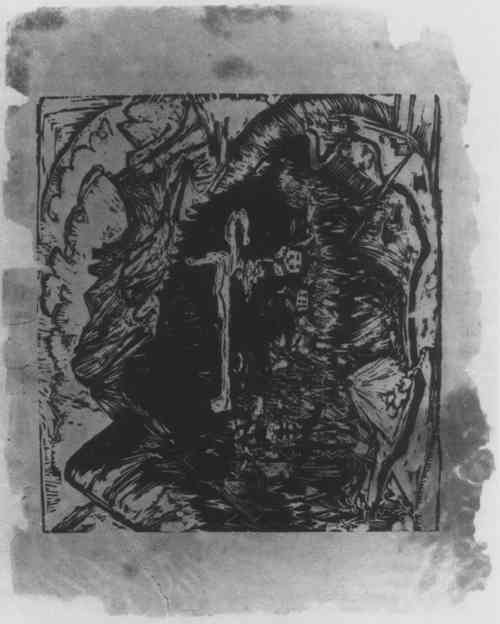TREATMENT OF A SALT IMPREGNATED WOODCUT BY E.L. KIRCHNERWeston Craigen
1 INTRODUCTIONTHIS PAPER describes the conservation of an impression of Junkernboden by Ernst Ludwig Kirchner, executed in 1918 and now in the collection of the Fogg Art Museum. Junkernboden is a woodcut printed in black ink; it depicts a scene in the Swiss Alps. When first examined by the author, the print was in such a weak condition that it could be stored only in a horizontal position, resting on a rigid support (Fig. 1). It was impossible to handle the sheet directly; any attempt to lift the unsupported print caused the paper to break into small fragments. Turning it over required that it be sandwiched between two stiff supports and then inverted.
The surface apperance of the paper was granular and generally white. Visual examination with a binocular microscope at 10x magnification showed that the paper surface was extremely irregular, with a topography of “mountains” and “valleys”.1 Small holes gave the sheet a “pock-marked” appearance visible to the naked eye, and the paper was covered with a coarse crystalline substance. A finger rubbed gently across the sheet would dislodge this substance together with paper fibers. In short, the print was virtually untouchable and completely unexhibitable. There was a brown stain on the print, localized in the lower left corner. The margins of the verso exhibited brown residues of adhesive from pressure-sensitive tapes. Also, brown staining corresponding to the inked areas of the image, probably related to the oil in the ink, was visible on the verso. None of these local disfigurements seemed to be the cause of the print's damaged state. Before actual treatment could be undertaken two problems had to be solved: 1) to discover the cause of the deterioration, which was believed to be related to the unknown crystalline material permeating the sheet, and 2) to devise a treatment that would return the print to exhibitable condition. It must be emphasized that it was by no means certain that the print could ever be made structurally secure. |
